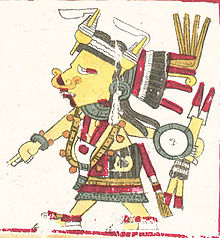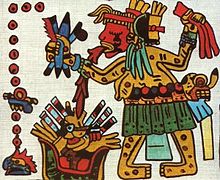Tlazolteotl



Tlazolteotl ( Nahuatl : dirt eater, tlazolli , the dirt, the disease) was the goddess of lust and forbidden love in Aztec mythology . She was also known as Tlaelquani (the one who eats unclean things) and was considered the goddess of repentance and purification.
Assignments
Tlazolteotl was seen as the third phase of the moon goddess Coyolxauhqui . Presumably the Aztecs had taken them over from the Huaxtecs . Tlazolteotl is also known by the nicknames Tlazolmiquiztli (death in lust) and Ixcuina (the one with the two faces) or Ixcuinan . In the Historia general de las cosas de la Nueva España describes Bernardino de Sahagún Ixcuinan as Numen in the plural, as the embodiment of four sisters who are each at different ages: Tiacapan (the firstborn), Teicu (the younger sister), Tlaco (the middle sister) and Xocotzin (the youngest sister). Tlazolteotl was also known as Cinteotl's mother . In the 260-day cycle of the Aztec calendar , the 13th Trecena from one earthquake to thirteen water was assigned to her. Another nickname of the Tlazolteotl was mother of the gods . As such, she was considered the earth goddess.
roll
Tlazolteotl was the one who seduced people into fornication, adultery and sexual debauchery. She was also seen as the carrier of venereal diseases, which were often interpreted as a punishment for sexual debauchery. At the same time, however, it was she who forgave these sins again, who cleansed the sinner through her "muck-eating". This double function was expressed by the nickname Ixcuina. Aztec prostitutes framed their mouths with melted black gum to indicate their association with tlazolteotl. They saw themselves as priestesses of the goddess of dirt, as they absorbed the bad passions of their suitors.
confession
Tlazolteotl was the female deity involved in the Aztec confession ritual. Her male counterpart in this task was Tezcatlipoca , who sees everything, is invisible and omnipresent. In contrast to Christian confession, however, Aztec confession was only intended once in a lifetime. Serious illness was considered a suitable time, especially if it was linked to moral offenses. The sinner turned to a tlapouhqui who had priestly functions and who set the appropriate day for confession. To initiate the ritual, he called Tlazolteotl and Tezcatlipoca:
Mother of Gods, Father of Gods, oh old God,
a poor man comes to you.
He comes in tears, sad and afraid.
Maybe he made mistakes.
Perhaps he was absent and lived in impurity.
... his heart ... is laden with grief ...
help in his need and calm his heart.
Then the penitent was called to disclose all injustice he had ever done, and the priest then issued appropriate penitential exercises. This included fasting, abstinence or cupping the tongue, which was pierced with thorny branches. The priest had to remain silent about the contents of the confession.
literature
- Heike Owusu: symbols of the Inca, Maya and Aztecs . Schirner Verlag, Darmstadt 2000, ISBN 3-89767-073-9
- Karl Taube : Aztec and Mayan Myths . Phillip Reclam jun., Stuttgart 1994, ISBN 3-15-010427-0
- George C. Vaillant: The Aztecs . M. Dumont Schaumberg, Cologne 1957
- Mary Miller , Karl Taube: An Illustrated Dictionary of the Gods and Symbols of Ancient Mexico and the Maya . Thames and Hudson, London 1997, ISBN 0-500-27928-4
- Jacques Soustelle: This is how the Aztecs lived on the eve of the Spanish conquest . German publishing house, Stuttgart 1956
Web links
References and comments
- ^ Karl Taube: Aztec and Maya myths , page 57
- ↑ Heike Owusu: Symbols of the Inca, Maya and Aztecs , page 211
- ^ Jacques Soustelle: How the Aztecs Lived on the Eve of the Spanish Conquest , page 136
- ↑ George C. Vaillant: The Aztecs , page 181
- ^ Mary Miller, Karl Taube: An Illustrated Dictionary of the Gods and Symbols of Ancient Mexico and the Maya , 168
- ↑ George C. Vaillant: The Aztecs, page 181
- ↑ George C. Vaillant: The Aztecs , page 132
- ↑ Jacques Soustelle: This is how the Aztecs lived on the eve of the Spanish conquest , page 241
- ↑ Fire god Huehueteotl
- ↑ Jacques Soustelle How the Aztecs Lived on the Eve of the Spanish Conquest, page 242